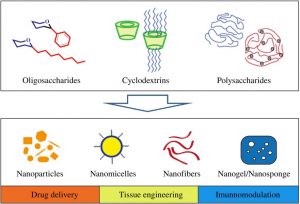Carbohydrates are the most abundant class of biopolymers on earth, serving in areas such as energy storage and materials with structural function. Simple mono- or disaccharides, as well as complex, polymeric systems provide an exciting source of cheap, biocompatible, and renewable materials.
Recently, the involvement of carbohydrates in several biological processes, like cell communication, inflammation, and immune response, has become evident and has inspired scientists to exploit carbohydrates for advanced biomedical applications. In particular, carbohydrates possess a strong tendency to form supramolecular networks, like nanoparticles or gels, and have found application in drug delivery, imaging, and tissue engineering.
 In a recent WIREs Nanomedicine and Nanobiotechnology review by Dr. Martina Delbianco and coworkers, recent research and challenges in the field of carbohydrate materials are discussed.
In a recent WIREs Nanomedicine and Nanobiotechnology review by Dr. Martina Delbianco and coworkers, recent research and challenges in the field of carbohydrate materials are discussed.
The large variety of natural carbohydrates, from monosaccharides to cyclic systems to charged or neutral polymers, has given rise to a range of materials with tunable properties. Chemical modifications serve to further tune the shape and properties of these materials.
Such materials are “glued” together by a multitude of weak interactions, making the formation of carbohydrate-based materials reversible. This property is often exploited for the creation of systems that can degrade in response to a stimulus, and for example, release a cargo on command. Similarly, the reversible association of carbohydrate-based nanomaterials is particularly useful for implants and tissue engineering.
Reproducibility is one of the main challenges faced by researchers studying carbohydrate materials. Carbohydrates obtained from natural sources often contain impurities, making analysis and quality control very difficult. In addition, chemical modifications, that serve to tune the polysaccharides properties, are limited. To date, purely synthetic systems are based on simple mono- and disaccharides. However, with the development of new synthetic techniques, quick access to complex, well-defined carbohydrates has become imaginable and novel synthetic glycomaterials with tunable properties can be envisioned.
Kindly contributed by the Authors.

















